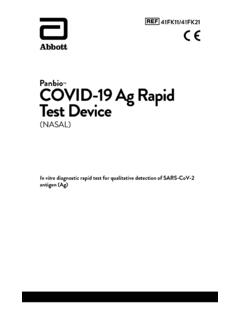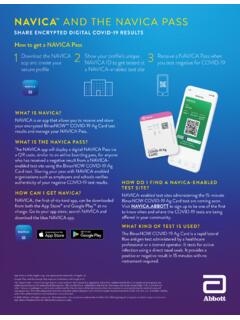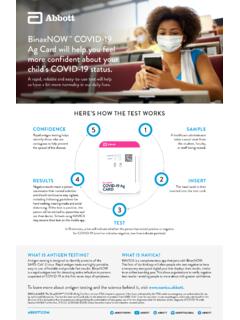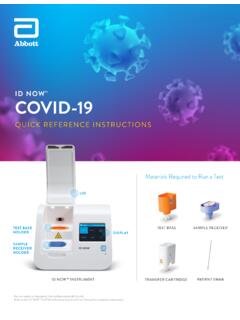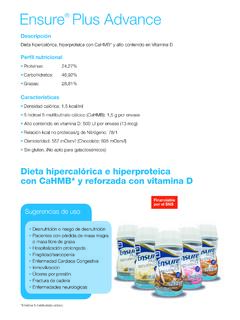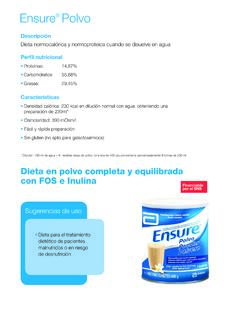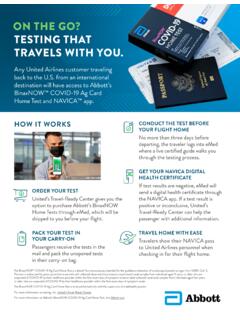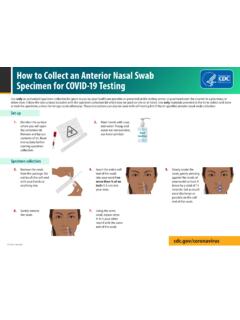Transcription of Panbio COVID-19 Ag Rapid Test Device - Abbott Laboratories
1 41FK10. Panbio . COVID-19 Ag Rapid Test Device (NASOPHARYNGEAL). In vitro diagnostic Rapid test for qualitative detection of SARS-CoV-2. antigen (Ag). In-vitro diagnostischer Schnelltest zum qualitativen Nachweis von SARS-CoV-2 Antigen (Ag). Prueba r pida de diagn stico In vitro para la detecci n cualitativa del ant geno (Ag) del SARS-CoV-2. Test rapide de diagnostic in vitro pour la d tection qualitative de l'antig ne SARS-CoV-2 (Ag). Test diagnostico rapido in vitro per la ricerca qualitativa dell'antigene SARS-CoV-2 (Ag). Teste r pido de diagn stico in vitro para detec o qualitativa do ant geno SARS-CoV-2 (Ag). Экспресс-тест in vitro для качественного определения антигена SARS-CoV-2 (Ag). About the Test EN. Introduction The Coronavirus disease ( COVID-19 ) is an infectious disease caused by a newly discovered coronavirus, severe acute respiratory syndrome coronavirus 2 (SARS-CoV-2)1. The SARS-CoV-2 is a -coronavirus, which is an enveloped non-segmented positive-sense RNA virus2.
2 It is spread by human-to-human transmission via droplets or direct contact, and infection has been estimated to have a mean incubation period of days and a basic reproduction number of Among patients with pneumonia caused by SARS-CoV-2, fever was the most common symptom, followed by cough3. The main IVD assays used for COVID-19 . employ real-time reverse transcriptase-polymerase chain reaction (RT- PCR) that takes a few hours4. The availability of a cost-effective, Rapid point-of-care diagnostic test is critical to enable healthcare professionals to aid in the diagnosis of patients and prevent further spread of the virus5. Antigen tests will play a critical role in the fight against covid -196. Test Principle Panbio COVID-19 Ag Rapid Test Device contains a membrane strip, which is pre-coated with immobilized anti-SARS-CoV-2 antibody on the test line and mouse monoclonal anti-chicken IgY on the control line. Two types of conjugates (human IgG specific to SARS-CoV-2.)
3 Ag gold conjugate and chicken IgY gold conjugate) move upward on the membrane chromatographically and react with anti-SARS- CoV-2 antibody and pre-coated mouse monoclonal anti-chicken IgY. respectively. For a positive result, human IgG specific to SARS-CoV-2. Ag gold conjugate and anti-SARS-CoV-2 antibody will form a test line in the result window. Neither the test line nor the control line are visible in the result window prior to applying the patient specimen . A visible control line is required to indicate a test result is valid. Intended Use Panbio COVID-19 Ag Rapid Test Device is an in vitro diagnostic Rapid test for the qualitative detection of SARS-CoV-2 antigen (Ag) in human nasopharyngeal swab specimens from individuals who meet COVID-19 . clinical and / or epidemiological criteria. Panbio COVID-19 Ag Rapid Test Device is for professional use only and is intended to be used as an aid in the diagnosis of SARS-CoV-2 infection.
4 The product may be used in any laboratory and non-laboratory environment that meets the requirements specified in the Instructions for Use and local regulation. ENGLISH. The test provides preliminary test results. Negative results don't preclude SARS-CoV-2 infection and they cannot be used as the sole basis for treatment or other management decisions. Negative results must be - 1 - combined with clinical observations, patient history, and epidemiological information. The test is not intended to be used as a donor screening test for SARS-CoV-2. Materials Provided 25 Test devices with desiccant in individual foil pouch Buffer (1 x 9 ml/bottle). 25 Extraction tubes 25 Extraction tube caps 1 Positive control swab 1 Negative control swab 25 Sterilized nasopharyngeal swabs for sample collection 1 Tube rack 1 Quick reference guide (Nasopharyngeal). 1 Instructions for use Materials Required but not Provided Personal Protective Equipment per local recommendations ( gown/lab coat, face mask, face shield/eye goggles and gloves), Timer, Biohazard container Active Ingredients of Main Components 1 Test Device Gold conjugate: Human IgG specific to SARS-CoV-2.
5 Ag gold colloid and Chicken IgY - gold colloid, Test line: Mouse monoclonal anti-SARS-CoV-2, Control line: Mouse monoclonal anti-Chicken IgY. Buffer Tricine, Sodium Chloride, Tween 20, Sodium Azide (< ), Proclin 300. Storage and Stability 1. The test kit should be stored at a temperature between 2-30 C. Do not freeze the kit or its components. Note: When stored in a refrigerator, all kit components must be brought to room temperature (15-30 C) for a minimum of 30. minutes prior to performing the test. Do not open the pouch while components come to room temperature. 2. The Buffer bottle may be opened and resealed for each assay. The Buffer cap should be firmly sealed between each use. The Buffer is ENGLISH. stable until expiration date if kept at 2-30 C. 3. Perform the test immediately after removing the test Device from the foil pouch. - 2 - 4. Do not use the test kit beyond its expiration date. 5. The shelf life of the kit is as indicated on the outer package.
6 6. Do not use the test kit if the pouch is damaged or the seal is broken. 7. Direct swab specimens should be tested immediately after collection . If immediate testing is not possible, the swab specimen can be kept in an extraction tube filled with extraction buffer (300 l) at room temperature (15-30 C) for up to two hours prior to testing. Warnings 1. For in vitro diagnostic use only. Do not reuse the test Device and kit components. 2. These instructions must be strictly followed by a trained healthcare professional to achieve accurate results. All users have to read the instruction prior to performing a test. 3. Do not eat or smoke while handling specimens. 4. Wear protective gloves while handling specimens and wash hands thoroughly afterwards. 5. Avoid splashing or aerosol formation of specimen and buffer. 6. Clean up spills thoroughly using an appropriate disinfectant. 7. Decontaminate and dispose of all specimens, reaction kits and potentially contaminated materials ( swab, extraction tube, test Device ) in a biohazard container as if they were infectious waste and dispose according to applicable local regulations.
7 8. Do not mix or interchange different specimens. 9. Do not mix reagent of different lots or those for other products. 10. Do not store the test kit in direct sunlight. 11. To avoid contamination, do not touch the head of provided swab when opening the swab pouch. 12. The provided sterilized swabs in the package should be used only for nasopharyngeal specimen collection . 13. To avoid cross-contamination, do not reuse the sterilized swabs for specimen collection . 14. Do not dilute the collected swab with any solution except for the provided extraction buffer. 15. The buffer contains < sodium azide as a preservative which may be toxic if ingested. When disposed of through a sink, flush with a large volume of ENGLISH. - 3 - Test Procedure (Refer to Figure). Nasopharyngeal Swab Specimens Note: Healthcare professionals should comply with personal safety guidelines including the use of personal protective equipment. Test Preparation 1.
8 Allow all kit components to reach a temperature between 15-30 C. prior to testing for 30 minutes. 2. Remove the test Device from the foil pouch prior to use. Place on a flat, horizontal and clean surface. 3. Hold the buffer bottle vertically and fill the extraction tube with buffer fluid until it flows up to the Fill-line of the extraction tube (300 l). Caution: If the amount of buffer is excessive or insufficient, an improper test result may occur. 4. Place the extraction tube in the tube rack. specimen collection & Extraction 1. Tilt the patient's head back slightly about 45 -70 to straighten the passage from the front of the nose. 2. Insert the swab with a flexible shaft through the nostril parallel to the palate. Caution: Use dedicated nasopharyngeal swab for specimen collection . 3. Swab should reach depth equal to distance from nostrils to outer opening of the ear. Caution: If resistance is encountered during insertion of the swab, remove it and attempt insertion in the opposite nostril.
9 4. Gently rub and roll the swab, 3-4 times. Leave the swab in place for several seconds to absorb secretions. 5. Slowly remove swab while rotating it and insert into the extraction tube. 6. Swirl the swab tip in the buffer fluid inside the extraction tube, pushing into the wall of the extraction tube at least five times and then squeeze out the swab by squeezing the extraction tube with your fingers. 7. Break the swab at the breakpoint and close the cap of extraction tube. Reaction with Test Device 1. Open the dropping nozzle cap at the bottom of the extraction tube. 2. Dispense 5 drops of extracted specimens vertically into the specimen ENGLISH. well (S) on the Device . Do not handle or move the test Device until the test is complete and ready for reading. Caution: Bubbles that occur in the extraction tube can lead to - 4 - inaccurate results. If you are unable to create sufficient drops, this may be caused by clogging in the dispensing nozzle.
10 Shake the tube gently to release the blockage until you observe free drop formation. 3. Close the nozzle and dispose of the extraction tube containing the used swab according to your local regulations and biohazard waste disposal protocol. 4. Start timer. Read result at 15 minutes. Do not read results after 20. minutes. 5. Dispose of the used Device according to your local regulations and biohazard waste disposal protocol. Positive / Negative Control Swab Note: Please refer to the External Quality Control section of this Instructions for use for the frequency of testing external quality control swabs. 1. Hold the buffer bottle vertically and fill the extraction tube with buffer fluid until it flows up to the Fill-line of the extraction tube (300 l). Caution: If the amount of buffer is excessive or insufficient, an improper test result may occur. 2. Place the extraction tube in the tube rack. 3. Insert the positive or negative control swab in the buffer fluid inside of the extraction tube and soak the swab for 1 minute.


